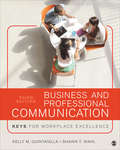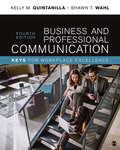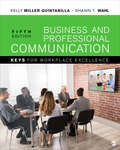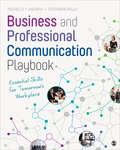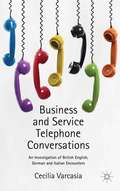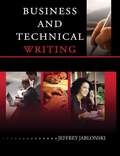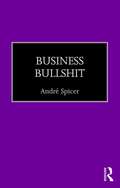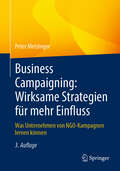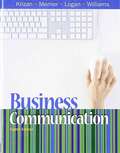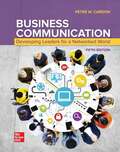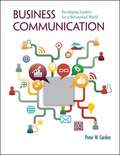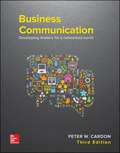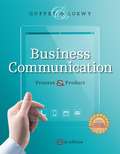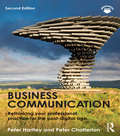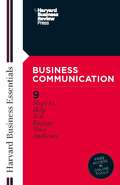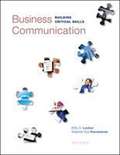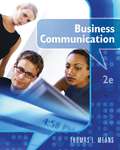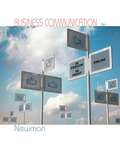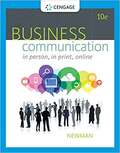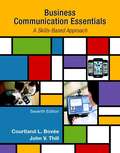- Table View
- List View
Business and Professional Communication: KEYS for Workplace Excellence
by Dr Kelly M. Quintanilla Dr Shawn T. WahlProfessional success requires excellent communication skills. Organized around the transition from student to professional life, Business and Professional Communication, Third Edition gives readers the tools they need to move from interview candidate to team member to leader. Kelly M. Quintanilla and Shawn T. Wahl help students understand the role communication plays when successfully handling situations like job interviewing, providing feedback to supervisors, and working in teams. The fully updated Third Edition includes expanded coverage of making competent choices in new communication channels, increased emphasis on skill building for business writing and presentations, and the effective use of visual aids.
Business and Professional Communication: KEYS for Workplace Excellence
by Dr Kelly M. Quintanilla Dr Shawn T. WahlProfessional success requires excellent communication skills. Organized around the transition from student to professional life, Business and Professional Communication, Third Edition gives readers the tools they need to move from interview candidate to team member to leader. Kelly M. Quintanilla and Shawn T. Wahl help students understand the role communication plays when successfully handling situations like job interviewing, providing feedback to supervisors, and working in teams. The fully updated Third Edition includes expanded coverage of making competent choices in new communication channels, increased emphasis on skill building for business writing and presentations, and the effective use of visual aids.
Business and Professional Communication: KEYS for Workplace Excellence
by Dr Kelly M. Quintanilla Dr Shawn T. WahlGain the knowledge and skills you need to move from interview candidate, to team member, to leader with this fully updated Fourth Edition of Business and Professional Communication by Kelly M. Quintanilla and Shawn T. Wahl. Accessible coverage of new communication technology and social media prepares you to communicate effectively in real world settings. With an emphasis on building skills for business writing and professional presentations, this text empowers you to successfully handle important work-related activities, including job interviewing, working in team, strategically utilizing visual aids, and providing feedback to supervisors. New to the Fourth Edition: A New “Introduction for Students” introduces the KEYS process to you and explains the benefits of studying business and professional communication. Updated chapter opening vignettes introduce you to each chapter with a contemporary example drawn from the real world, including a discussion about what makes the employee-rated top five companies to work for so popular, new strategies to update PR and marketing methods to help stories stand out, Oprah Winfrey’s 2018 Golden Globe speech that reverberated throughout the #metoo movement, Simon Sinek’s “How Great Leaders Inspire Action” TED talk, and the keys to Southwest Airlines’ success. An updated photo program shows diverse groups of people in workplace settings and provides current visual examples to accompany updated vignettes and scholarship in the chapter narrative.
Business and Professional Communication: KEYS for Workplace Excellence
by Dr Kelly M. Quintanilla Dr Shawn T. WahlGain the knowledge and skills you need to move from interview candidate, to team member, to leader with this fully updated Fourth Edition of Business and Professional Communication by Kelly M. Quintanilla and Shawn T. Wahl. Accessible coverage of new communication technology and social media prepares you to communicate effectively in real world settings. With an emphasis on building skills for business writing and professional presentations, this text empowers you to successfully handle important work-related activities, including job interviewing, working in team, strategically utilizing visual aids, and providing feedback to supervisors. New to the Fourth Edition: A New “Introduction for Students” introduces the KEYS process to you and explains the benefits of studying business and professional communication. Updated chapter opening vignettes introduce you to each chapter with a contemporary example drawn from the real world, including a discussion about what makes the employee-rated top five companies to work for so popular, new strategies to update PR and marketing methods to help stories stand out, Oprah Winfrey’s 2018 Golden Globe speech that reverberated throughout the #metoo movement, Simon Sinek’s “How Great Leaders Inspire Action” TED talk, and the keys to Southwest Airlines’ success. An updated photo program shows diverse groups of people in workplace settings and provides current visual examples to accompany updated vignettes and scholarship in the chapter narrative.
Business and Professional Communication: KEYS for Workplace Excellence
by Shawn T. Wahl Kelly MillerOrganized around the transition from student to professional life, Business and Professional Communication, Fifth Edition gives readers the tools they need to move from interview candidate to team member to leader. Coverage of new communication technology and social media, and an emphasis on building skills for business writing and presentations help students gain a deeper understanding of the role of communication in successfully handling situations like job interviewing, providing feedback to supervisors, and working in teams. This title is accompanied by a complete teaching and learning package. Learning Platform / Courseware SAGE Vantage is an intuitive learning platform that integrates quality SAGE textbook content with assignable multimedia activities and auto-graded assessments to drive student engagement and ensure accountability. Unparalleled in its ease of use and built for dynamic teaching and learning, Vantage offers customizable LMS integration and best-in-class support. It’s a learning platform you, and your students, will actually love. Assignable Video with Assessment Assignable video (available in SAGE Vantage) is tied to learning objectives and curated exclusively for this text to bring concepts to life. LMS Cartridge: Import this title’s instructor resources into your school’s learning management system (LMS) and save time. Don’t use an LMS? You can still access all of the same online resources for this title via the password-protected Instructor Resource Site.
Business and Professional Communication: KEYS for Workplace Excellence
by Shawn T. Wahl Kelly MillerOrganized around the transition from student to professional life, Business and Professional Communication, Fifth Edition gives readers the tools they need to move from interview candidate to team member to leader. Coverage of new communication technology and social media, and an emphasis on building skills for business writing and presentations help students gain a deeper understanding of the role of communication in successfully handling situations like job interviewing, providing feedback to supervisors, and working in teams. This title is accompanied by a complete teaching and learning package. Learning Platform / Courseware SAGE Vantage is an intuitive learning platform that integrates quality SAGE textbook content with assignable multimedia activities and auto-graded assessments to drive student engagement and ensure accountability. Unparalleled in its ease of use and built for dynamic teaching and learning, Vantage offers customizable LMS integration and best-in-class support. It’s a learning platform you, and your students, will actually love. Assignable Video with Assessment Assignable video (available in SAGE Vantage) is tied to learning objectives and curated exclusively for this text to bring concepts to life. LMS Cartridge: Import this title’s instructor resources into your school’s learning management system (LMS) and save time. Don’t use an LMS? You can still access all of the same online resources for this title via the password-protected Instructor Resource Site.
Business and Professional Communication Playbook: Essential Skills for Tomorrow′s Workplace
by Michelle T. Violanti Stephanie E. KellyBusiness and Professional Communication Playbook teaches students the essentials of business communication and necessary skillset that employers look for today. Michelle Violanti and Stephanie Kelly use engaging examples, provide tips on how to carry yourself professionally, and incorporate real-life experiences from recent graduates to teach students how to communicate like a professional. Focused, bite-sized chapters on the most important topics in business communication, such as interviewing, writing resumes, and leading team presentations will motivate students to read and prepare ahead of time so instructors can focus on skill-building during class. By using this simple and flexible format, this text will provide students and instructors with an excellent foundation for a successful Business Communication course. This title is accompanied by a complete teaching and learning package in SAGE Vantage, an intuitive learning platform that instructors and students actually love.
Business and Professional Communication Playbook: Essential Skills for Tomorrow′s Workplace
by Michelle T. Violanti Stephanie E. KellyBusiness and Professional Communication Playbook teaches students the essentials of business communication and necessary skillset that employers look for today. Michelle Violanti and Stephanie Kelly use engaging examples, provide tips on how to carry yourself professionally, and incorporate real-life experiences from recent graduates to teach students how to communicate like a professional. Focused, bite-sized chapters on the most important topics in business communication, such as interviewing, writing resumes, and leading team presentations will motivate students to read and prepare ahead of time so instructors can focus on skill-building during class. By using this simple and flexible format, this text will provide students and instructors with an excellent foundation for a successful Business Communication course. This title is accompanied by a complete teaching and learning package in SAGE Vantage, an intuitive learning platform that instructors and students actually love.
Business and Professional Writing: A Basic Guide for Americans
by Paul MacraeStraightforward, practical, and focused on realistic examples, Business and Professional Writing: A Basic Guide for Americans is an introduction to the fundamentals of professional writing. The book emphasizes clarity, conciseness, and plain language. Guidelines and templates for business correspondence, formal and informal reports, brochures and press releases, and oral presentations are included. Exercises guide readers through the process of creating and revising each genre, and helpful tips, reminders, and suggested resources beyond the book are provided throughout.
Business and Service Telephone Conversations
by Cecilia VarcasiaThis book considers the sequential deployment of the receiver's response to the caller's request in telephone service encounters between native speakers in the U. K, Germany and Italy analysing the different response formats and their grammatical configuration.
Business and Technical Writing
by Jeffrey JablonskiExperts now believe that multiple literacies are necessary for communicating effectively in today's business and technical settings. Part I of this textbook acquaints you with these literacies as well as the typical genres, or forms, of business and technical writing, including memos, letters, e-mails, resumes, reports, and presentations. Part II of this textbook offers a number of writing projects that require you to apply the relevant principles of effective written communication from Part I.
Business Bullshit
by André SpicerOur organizations are flooded with empty talk. We are constantly "going forward" to lands of "deliverables", stopping off on the "journey" to "drill down" into "best practice". Being an expert at using management speak has become more important in corporate life than delivering long lasting results. The upshot is that meaningless corporate jargon is killing our organizations. <P><P>In this book, management scholar the author argues we need to call this empty talk what it is: bullshit. The book looks at how organizations have become vast machines for manufacturing, distributing and consuming bullshit. It follows how the meaningless language of management has spread through schools, NGOs, politics and the media. <P><P>Business Bullshit shows you how to spot business bullshit, considers why it is so popular, and outlines the impact it has on organizations and the people who work there. It also outlines what we can do to minimise bullshit at work. The author makes a case for why organizations need to avoid empty talk and reconnect with core activities.
Business Campaigning: Was Unternehmen von NGO-Kampagnen lernen können
by Peter MetzingerDieses Buch ist die dritte Auflage von Business Campaigning, einem 1998 durch Peter Metzinger entwickelten Konzept. Es basiert auf der Erfahrung des Autors aus mehr vier Jahrzehnten Campaigning-Praxis auftun ist dabei auch stark vom Denken des Physikers geprägt. Business Campaigning ist ein Meta-Konzept, das dabei hilft, die öffentliche Meinung oder das Verhalten von Zielgruppen zu beeinflussen, um geschäftliche oder politische Ziele zu erreichen. Es umfasst die Planung und Durchführung von Veränderungsprozessen – auch Kampagnen sind Veränderungsprozesse –, mittels einer Systematik, die sowohl für Politik, als auch Change Management, Marketing und Unternehmenskommunikation geeignet ist. Der Schlüssel zum erfolgreichen Business Campaigning liegt in der systematischen und strukturierten Vorgehensweise.
Business Communication
by A.C. "Buddy" Krizan; Merrier Patricia Logan Joyce P. Williams Karen SchneiterThe new, cutting-edge BUSINESS COMMUNICATION, 8e helps take your communication skills to a higher level by combining up-to-date technology with stellar content to give you the foundations needed for success in business. Reflecting today's e-inundated marketplace, this comprehensive text covers the basics for all forms of business communication, from letters to e-mail, business plans to presentations, listening skills to nonverbal messages, diversity to teamwork, visual aids to Web blogs, interpersonal communication to twitter, and everything in between.
Business Communication: Developing Leaders for a Networked World
by Peter CardonIn Business Communication: Developing Leaders for a Networked World, Peter Cardon is taking a practitioner and case-based approach to help students develop an understanding of how course content applies to the business world. Maintaining a central theme of credibility, the author communicates why credibility is essential to effective communication. Integrated with Connect for Business Communication, Cardon provides a contemporary yet traditional view into the field, empowering students to learn bedrock communication principles while also staying up-to-date with cultural and technological changes in the business world—transforming them into leaders for a networked world.
Business Communication: Developing Leaders For A Networked World
by Peter W. CardonThe Business Communication field is at a crossroads as communication technologies are reshaping how people communicate in the workplace. Business Communication: Developing Leaders for a Networked World, by Peter Cardon, puts students at the center of business communication through the author's unique focus on credibility woven throughout the textbook chapters, forward looking vision built on traditional concepts, and practitioner and case-based approach. Students are more likely to read and reflect on the text, and are better positioned to understand the essentials of efficient and effective business communication, thereby transforming them into leaders for a networked world.
Business Communication: Developing Leaders for a Networked World (Third Edition)
by Peter W. CardonBusiness Communication: Developing Leaders for a Networked World, by Peter Cardon, puts students at the center of business communication through the author's unique focus on credibility woven throughout the textbook chapters, forward looking vision built on traditional concepts and practitioner and case-based approach. Students are more likely to read and reflect on the text, and are better positioned to understand the essentials of efficient and effective business communication, thereby transforming them into leaders for a networked world.
Business Communication: Process & Product
by Mary Ellen Guffey Dana LoewyA trusted market leader, BUSINESS COMMUNICATION: PROCESS AND PRODUCT presents the market's most innovative coverage of workplace communication skills with an expanded emphasis on digital writing.
Business Communication: Rethinking your professional practice for the post-digital age
by Peter Hartley Peter ChattertonEffective communication in business and commercial organizations is critical, as organizations have to become more competitive and effective to sustain commercial success. This thoroughly revamped new edition distils the principles of effective communication and applies them to organizations operating in the digital world. Techniques and processes detailed in the book include planning and preparing written communication, effective structures in documents, diverse writing styles, managing face-to-face interactions, using visual aids, delivering presentations, and organising effective meetings. In every case the authors consider the potential of new technology to improve and support communication. With helpful pedagogical features designed to aid international students, this new edition of a popular text will continue to aid business and management students for years to come. Additional content can now be found on the author's website - www.rethinkbuscomm.net
Business Communication
by Harvard Business School PressWith advice and tools for improving a wide array of communication skills--from delivering an effective presentation to drafting proposals to the effective use of e-mail--Business Communication helps managers deliver information effectively.
Business Communication: Building Critical Skills
by Stephen Kaczmarek Kitty LockerBusiness Communication: Building Critical Skills was built to provide the ultimate in freedom, flexibility, and focused classroom. Broken into 30 modular chapters, this text provides topic-focused modules, allowing instructors to customize their resources piece-by-piece to best suite their course and teaching style. Each module has a strong workplace activity orientation, supporting students to build critical skills in writing, speaking, and listening. Locker/Kaczmarek is grounded in solid business communication fundamentals, and supports students to piece together what is needed to be a successful communicator for the 21st century.
Business Communication
by Thomas L. MeansEquip students with the communication tools needed for success in today's workplace with this comprehensive, business-savvy text! Business Communication 2e has an exciting new contemporary design with clear easy-to-follow instructions guiding students through the chapters. Two new chapters have been added to this edition, increasing the emphasis on English Grammar and Writing Mechanics. Help students master the basics of workplace communication with proven instructional techniques, time-tested learning approaches, and complete teacher support. Topics such as exchanging information via telecommunications software, electronic mail, images and multimedia, and on-line information services are presented. Students refine writing, listening, speaking, computing, and research skills while using the latest technology tools. This text is ideal for the year-long business communication class. Business Communication 2e is the total solution for teachers who want comprehensive coverage of business document preparation.
Business Communication: In Person, In Print, Online
by Amy Newman<P>BUSINESS COMMUNICATION: IN PERSON, IN PRINT, ONLINE, 9E offers a realistic approach to communication in today's organizations.<P> The text covers the most important business communication concepts in detail and thoroughly integrates coverage of today's social media and other communication technologies.<P> Building on core written and oral communication skills, the ninth edition helps readers make sound medium choices and provides guidelines and examples for the many ways people communicate at work. <P>Readers learn how to create PowerPoint decks, use instant messaging and texting effectively at work, engage customers using social media, lead web meetings and conference calls, and more.
Business Communication: In Person, In Print, Online
by Amy NewmanDiscover a realistic approach to communication in today's organizations with BUSINESS COMMUNICATION: IN PERSON, IN PRINT, ONLINE, 10E. You learn today's most important business communication concepts in detail and within the context of how communication happens in organizations today. Company examples and situations demonstrate how principles work in the real business world. In addition to refining core written and oral communication skills, you learn to navigate complex relationships and use current, sophisticated technologies. You master the skills to create PowerPoint decks, manage your online reputation with LinkedIn and other tools, engage customers using social media, lead web meetings and conference calls, and more. With self-reflection questions throughout the book, you develop a deeper understanding of yourself and how to communicate most effectively to reach your personal and professional goals.
Business Communication Essentials
by Courtland V. Bovee John V. ThillBusiness Communication Essentials equips students with fundamental skills for a career in the modern, mobile workplace. With comprehensive coverage of writing, listening, and presentation strategies in a contemporary context, this text balances basic business English, communication approaches, and the latest technology in one accessible volume. Over the last two decades, business communication has been in constant flux, with email, web content, social media, and now mobile changing the rules of the game. In the Seventh Edition, Bovee and Thill provide abundant exercises, tools, and online resources to prepare students for the new reality of mobile communications and other emerging trends, ensuring a bright start in the business world.
